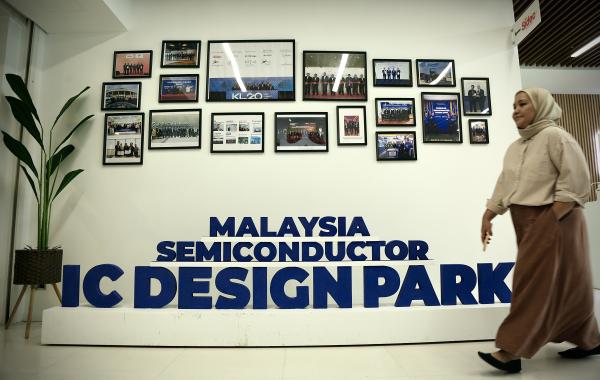By Danial Dzulkifly
SHAH ALAM, March 10 — Selangor’s goal to lead Malaysia’s deep tech and semiconductor industries is taking shape, with the state’s Integrated Circuit (IC) Design Park spearheading innovation in artificial intelligence (AI) and chip design.
The initiative is positioning Malaysia and, by extension, Selangor, as a key player in the global semiconductor supply chain while reinforcing its status as a digital and data centre hub.
Since its launch, the IC Design Park has facilitated the development of AI-powered semiconductor products, with several innovations set to reach the consumer market in the coming years.
Selangor Information Technology and Digital Economy Corporation (Sidec) chief executive officer Yong Kai Ping said the park plays a crucial role in nurturing local talent and attracting international partnerships, further cementing Selangor’s importance in the national and soon global semiconductor ecosystem.
“We are seeing real progress. The IC Design Park has nurtured local talent and strengthened our semiconductor capabilities. With further development, we expect to see AI products designed here making their way into homes, businesses, and industries,” he said in a recent interview with Media Selangor.
The park has secured full occupancy by global semiconductor firms, including MaiStorage, Skyechip, Weeroc, AppAsia ChipsBank, and SensoremTek Sdn Bhd.
It has also established partnerships with major industry players such as SoftBank’s ARM Holdings and Phison. The initiative is expected to create over 400 high-value jobs for IC design engineers in its first year, providing a significant boost to Malaysia’s hi-tech workforce.
[caption id="attachment_392789" align="aligncenter" width="1200"] Selangor Information Technology and Digital Economy Corporation chief executive officer Yong Kai Ping seen at the Puchong Financial Corporate Centre in Bandar Puteri on February 18, 2024. — Picture by MOHD KHAIRUL HELMY MOHD DIN/MEDIA SELANGOR[/caption]
Selangor Information Technology and Digital Economy Corporation chief executive officer Yong Kai Ping seen at the Puchong Financial Corporate Centre in Bandar Puteri on February 18, 2024. — Picture by MOHD KHAIRUL HELMY MOHD DIN/MEDIA SELANGOR[/caption]
A second IC Design Park is set to be launched in Cyberjaya this year, with Selangor aiming to establish one such facility per year until 2028.
The initiative is expected to attract 25 to 30 leading semiconductor firms over the next five years, generating an estimated RM100 billion in export revenue and RM38 billion in potential income.
Sidec is also preparing several startups and enterprises incubated in the IC Design Park for public listing, with targeted initial public offerings anticipated between 2027 and 2028, said Yong.
To further support industry growth, he pointed to the recent launch of the Malaysian AI and Semiconductor Academy (Asem), with a new campus being developed in Cyberjaya.
The academy aims to train up to 2,000 IC design engineers and 2,000 professionals in packaging engineering, strengthening the country’s semiconductor talent pipeline.
“We need to align talent development with industry needs. Asem will equip our graduates with the necessary skills, ensuring they are job-ready and able to contribute to the semiconductor sector from day one,” Yong added.
Malaysia’s expanding role in the global data centre industry is also closely linked to semiconductor innovation.
As AI and cloud computing continue to drive demand for high-performance chips, the country’s strategic location between East and West has made it a preferred destination for data centre investments.
[caption id="attachment_367130" align="aligncenter" width="1200"] Menteri Besar Dato’ Seri Amirudin Shari (left) and Economy Minister Rafizi Ramli sign an officiation plaque at the launch of Malaysia’s first IC Design Park at the Puchong Financial Corporate Centre on August 6, 2024. — Picture by MOHD KHAIRUL HELMY MOHD DIN/MEDIA SELANGOR[/caption]
Menteri Besar Dato’ Seri Amirudin Shari (left) and Economy Minister Rafizi Ramli sign an officiation plaque at the launch of Malaysia’s first IC Design Park at the Puchong Financial Corporate Centre on August 6, 2024. — Picture by MOHD KHAIRUL HELMY MOHD DIN/MEDIA SELANGOR[/caption]
Yong also said Malaysia hosts major players such as ByteDance from China, alongside Western tech giants like Amazon, Microsoft, and Google, providing it with a competitive edge in the region.
“Not many countries can provide an ecosystem where both Chinese and Western firms feel comfortable operating. Malaysia’s neutrality and strong digital infrastructure make it an attractive hub for data centre investments,” he said.
However, he acknowledged growing environmental concerns over the high power and water consumption of data centres.
Rather than viewing this as a constraint, Yong sees it as an opportunity for Malaysia to lead in sustainable data centre management.
“There is an urgent need to develop utility companies that specialise in sustainable data centre operations. By doing so, we can mitigate environmental impact while still expanding our digital economy,” he said.
Sidec is also advocating for greater investment in green energy solutions to support data centre expansion, including solar and hydroelectric power integration.
Yong stressed the importance of collaboration between the government and private sector to ensure Malaysia remains a leader in digital technology while maintaining its environmental commitments.
During the tabling of the 2025 Selangor State Budget on November 15 last year, Menteri Besar Dato’ Seri Amirudin Shari announced the state government will propose an AI white paper in the upcoming assembly sitting.
The initiative aims to enhance government service efficiency, audit AI technologies, and explore AI integration as a complementary workforce tool.




